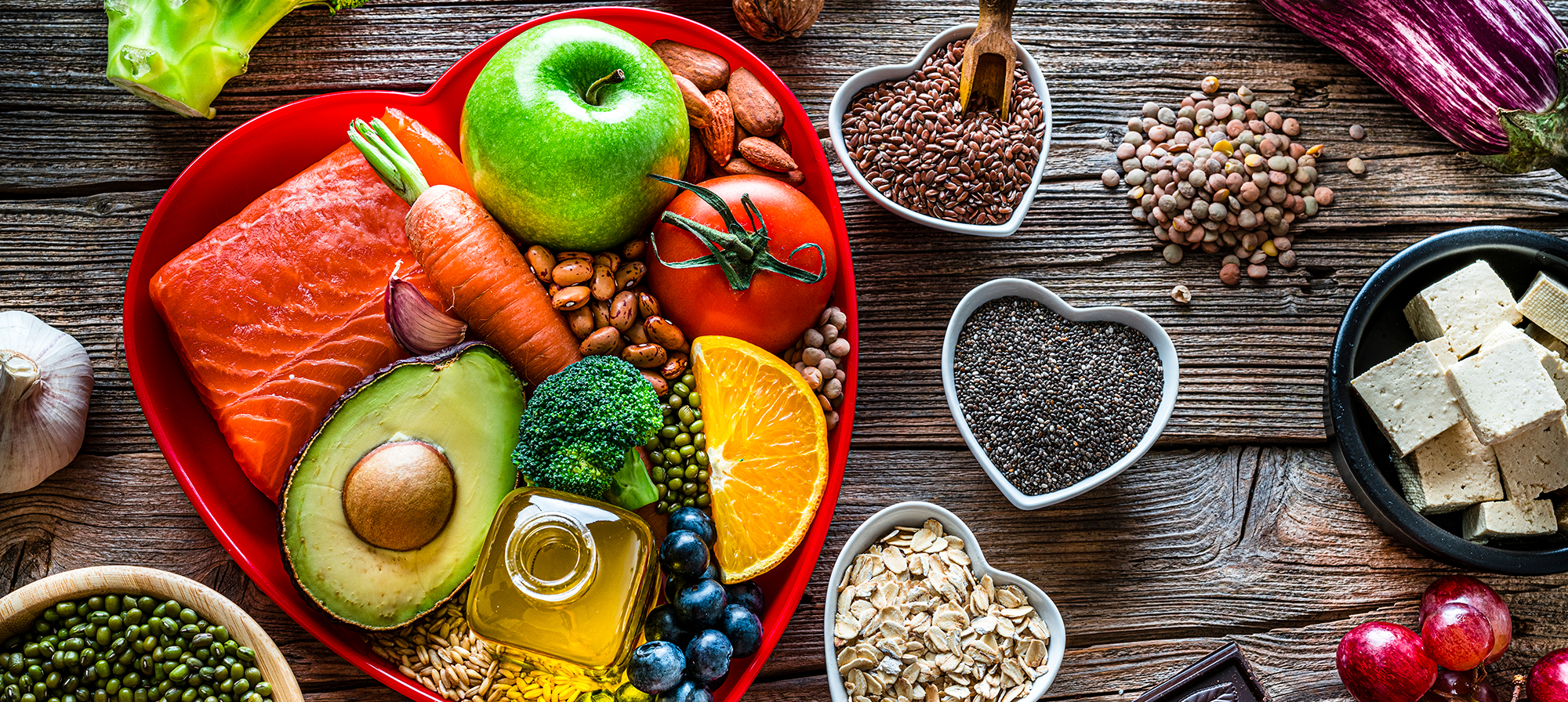Heart disease is a potentially devasting condition that affects the lives of millions of families every year. But one important thing to remember about heart disease is that it is largely preventable. It’s also manageable. Adopting heart-healthy eating habits can help you do both.
Of course, changing the way you eat may not be so simple if you have habits that have been with you for years. But it doesn’t have to be difficult. And you don’t necessarily have to stop eating your favorites or only eat certain foods. Cutting back on some foods and indulging in them less often could help lessen your risks.
Adopting heart-healthy eating habits is easier when you start with small changes. Don’t try to make big sweeping changes all at once. Make one small change at a time, and then build on that to eventually create an overall healthy eating routine.
Discover how to break free from a food rut and why your health will thank you if you do.
 How a healthy diet benefits your heart health
How a healthy diet benefits your heart health
While a healthy diet isn’t the only way to support your heart health, it is one of the key components. Making smart choices about what you eat is beneficial for your heart in many ways. Some research shows it can help you lower your risk for:
- Becoming overweight or obese
- Type 2 diabetes
- High blood pressure
- High blood lipids (e.g., LDL cholesterol, triglycerides)
Here are 8 ways you can embrace a heart-healthy eating plan. Remember, you don’t have to adopt all of these at once. Tackle them one at a time.
- Eat ample fruits and vegetables. Fruits and vegetables are loaded with nutrients and fiber that can support your overall health, as well as that of your heart and blood vessels. They also have natural plant chemicals and fiber, both of which may support healthy blood lipid levels. Fiber may also help support healthy blood pressure. And because they’re low in calories, you can fill up on them. Aim for 2–3 servings of veggies and 1½–2 servings of fruit each day.

- Choose whole grains. Look for foods made with whole grains rather than “refined” or “enriched” grains. Whole grains have all their nutrients intact. They are also excellent sources of dietary fiber, which can help improve blood lipid levels and in turn lower the risk of heart attack and obesity.

- Include healthy sources of lean and high-fiber protein. This could include plant proteins like nuts or beans. Good sources of protein also include fish or other seafood and lean cuts of meat. Try to limit your intake of fatty or processed meats. In general, these meats have higher levels of saturated fats. Studies suggest that eating high levels of saturated fats can raise your blood lipid levels and lead to an increased risk of heart disease.

- Choose fats that support heart health. Research is mixed on whether saturated fat (found in red meat, lard, dairy, and fried foods) and/or how much of it increases your risk for heart disease. But some findings suggest a diet high in this type of fat, along with trans fats, may boost your blood lipids beyond healthy levels. You may want to talk with your doctor about how much saturated fat is safe for you.
In the meantime, it can’t hurt to eat more foods high in heart-healthy fats , such as unsaturated fats (like monounsaturated and polyunsaturated fats). These may support your heart health in a number of ways.
Omega-3 fats—one type of unsaturated fat—are thought to be especially protective of heart health. Research suggests omega-3 fats may help lower inflammation and the risk of blood clots. They may also help regulate heart rate and lower unhealthy LDL cholesterol levels. All of these benefits may in turn help lower the risk of heart disease.
Your body can’t make omega-3 fats. You need to get them from foods. Good sources include walnuts, almonds, flaxseeds, salmon, trout, and avocados. When cooking, choose olive, sunflower, canola, or sesame oils. You may want to limit using palm, coconut, or other tropical oils. The fats in these types of tropical plants contain a higher percentage of saturated fat than do other oils.
- Avoid ultra-processed foods. Processed foods—especially ultra-processed foods—are foods that are far removed from their natural state. These include fast foods, sugary drinks and cereals, and packaged snack foods like chips, candy, and cookies. They’re often injected with artificial flavors, added sugars, trans fats, or saturated fats. They also tend to have high levels of sodium and offer little to no nutritional value. Studies show that people with diets high in these types of foods may have an increased risk of heart disease.

- Limit added sugars. Check the labels on your foods and drinks for added sugars and try to keep them to a minimum. Food manufacturers like to add sweeteners to all kinds of foods to appeal to a consumer’s sweet tooth. In small amounts this is fine, but added sugars make their way into more foods and drinks than you may realize. Among other things, eating too much sugar can raise your triglyceride levels, a type of fat in the blood that may increase the risk of heart disease.

- Watch your sodium intake. While a certain amount of sodium is vital for your body, too much may not be a good thing. Packaged foods and restaurant foods tend to have very high levels of sodium. Adding salt to your food from the shaker will also boost sodium intake. Too much sodium may lead to high blood pressure in some people, which is a big risk for heart disease and other health concerns. Try to limit your sodium intake to less than 2,300 mg a day.

- Limit alcohol. Drinking too much alcohol can increase your risk of heart disease. For women, stick to no more than one drink per day; and for men, stick to no more than 2 drinks per day. If you don’t drink, your best bet is not to start. Keep in mind that you may be more sensitive to alcohol as you get older.

Making healthy changes to your eating habits isn’t always easy. Just take it one step at a time.
Think about talking with your doctor about your heart health, as well. They can help you get on the right path, not only with your diet, but with other heart-healthy habits—like exercise, smoking cessation, and stress management—if you’re having trouble.
If you are taking any medications to help lower your blood pressure or lipid levels, always take them exactly as instructed. But be careful not to assume that any medicines you take are a “magic pill.” Taking medications doesn’t mean you can suddenly eat any food you want without concern. Your doctor will be the first to tell you that a heart-healthy diet, exercise, stress management, and other habit changes are still a crucial part of an overall healthy lifestyle—including one that protects your heart health.
Not a Silver&Fit® member? Learn more about everything the program has to offer, including more helpful healthy living tips like this, here on our website.
This information is not intended to take the place of regular medical care or advice. Please check with your doctor before using this information or beginning any self-care program. Images used for this article do not depict any members of the Silver&Fit Program.
References
American Heart Association. (2024, August 23). Dietary fats. https://www.heart.org/en/healthy-living/healthy-eating/eat-smart/fats/dietary-fats
American Heart Association. (2024, June 25). Get to know your grains, why you need them, and what to look for. https://www.heart.org/en/healthy-living/healthy-eating/eat-smart/nutrition-basics/whole-grains-refined-grains-and-dietary-fiber
Bowen, K. J., Sullivan, V. K., Kris-Etherton, P. M., & Petersen, K. S. (2018, January 30). Nutrition and cardiovascular disease-an update. Current Atherosclerosis Report, 20(2), 8. https://doi.org/10.1007/s11883-018-0704-3
Centers for Disease Control and Prevention. (2024, May 15). About coronary artery disease (CAD). https://www.cdc.gov/heart-disease/about/coronary-artery-disease.html?CDC_AAref_Val=https://www.cdc.gov/heartdisease/coronary_ad.htm
Centers for Disease Control and Prevention. (2024, October 24). Heart disease facts. https://www.cdc.gov/heart-disease/data-research/facts-stats/?CDC_AAref_Val=https://www.cdc.gov/heartdisease/facts.htm
Centers for Disease Control and Prevention, National Center for Health Statistics. (2022). About Multiple Cause of Death, 1999–2020. CDC WONDER Online Database website. Atlanta, GA: Centers for Disease Control and Prevention; 2022.
Centers for Disease Control and Prevention. (2024, December 2). Heart disease risk factors. https://www.cdc.gov/heart-disease/risk-factors/
Cleveland Clinic. (2024, February 28). Why too much salt is bad for you. https://health.clevelandclinic.org/is-salt-bad-for-you/
Guasch-Ferre, M., Liu, G., Li, Y., Sampson, L., Manson, J. E., Salas-Salvado, J., Martinez-Gonzalez, M. A., Stampfer, M. J., Willett, W. C., Sun, Q., & Hu, F. B. (2020, April 21). Olive oil consumption and cardiovascular risk in U.S. adults. Journal of the American College of Cardiology, 75(15), 1729-1739. https://doi.org/10.1016/j.jacc.2020.02.036
Harvard T. H. Chan School of Public Health. (n.d.) Omega-3 fatty acids: An essential contribution. https://www.hsph.harvard.edu/nutritionsource/what-should-you-eat/fats-and-cholesterol/types-of-fat/omega-3-fats/#:~:text=Omega%2D3%20fats%20are%20a,sometimes%20called%20marine%20omega%2D3s.
Mayo Clinic. (2023, February 15). Dietary fat: Know which to choose. https://www.mayoclinic.org/healthy-lifestyle/nutrition-and-healthy-eating/in-depth/fat/art-20045550
National Heart, Lung, and Blood Institute. (2022, March 24). Heart attack: Causes and risk factors. https://www.nhlbi.nih.gov/health/heart-attack/causes
National Institute on Aging. (2022, July 19). Facts about aging and alcohol. https://www.nia.nih.gov/health/facts-about-aging-and-alcohol
United States Department of Agriculture. (2020, December). Dietary Guidelines for Americans 2020-2025. https://www.dietaryguidelines.gov/sites/default/files/2020-12/Dietary_Guidelines_for_Americans_2020-2025.pdf
Virani, S. S., Alonso, A., Aparicio, H. J., Benjamin, E. J., Bittencourt, M. S., Callaway, C. W., Carson, A. P., Chamberlain, A. M., Cheng, S., Delling, F. N., Elkind, M. S. V., Evenson, K. R., Ferguson, J. F., Gupta, D. K., Khan, S. S., Kissela, B. M., Knutson, K. L., Lee, C. D., Lewis, T. T., Liu, J., Loop, M. S., Lutsey, P. L., Ma, J., Mackey, J., Martin, S. S., Matchar, D. B., Mussolino, M. E., Navaneethan, S. D., Perak, A. M., Roth, G. A., Samad, Z., Satou, G. M., Schroeder, E. B., Shah, S. H., Shay, C. M., Stokes, A., VanWagner, L. B., Wang, N. Y., Tsao, C. W., American Heart Association Council on, E., Prevention Statistics, C., & Stroke Statistics, S. (2021, February 23). Heart Disease and Stroke Statistics-2021 Update: A report from the American Heart Association. Circulation, 143(8), e254-e743. https://doi.org/10.1161/CIR.0000000000000950
Wang, Z., Bergeron, N., Levison, B. S., Li, X. S., Chiu, S., Jia, X., Koeth, R. A., Li, L., Wu, Y., Tang, W. H. W., Krauss, R. M., & Hazen, S. L. (2019, February 14). Impact of chronic dietary red meat, white meat, or non-meat protein on trimethylamine N-oxide metabolism and renal excretion in healthy men and women. European Heart Journal, 40(7), 583-594. https://doi.org/10.1093/eurheartj/ehy799
This article was written by Jason Nielsen, edited by Gail Olson, and clinically reviewed by Elizabeth Thompson, MPH, RDN, on July 11, 2025.





